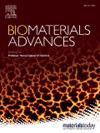一个可定制的骨肉瘤球形生成、成像和药物筛选的微图案平台
IF 6
2区 医学
Q2 MATERIALS SCIENCE, BIOMATERIALS
Materials Science & Engineering C-Materials for Biological Applications
Pub Date : 2025-07-17
DOI:10.1016/j.bioadv.2025.214419
引用次数: 0
摘要
球状体是三维细胞簇,可作为可靠的体外癌症药物筛选模型,模拟肿瘤微结构和化疗耐药性。尽管具有潜力,但目前的球形培养系统缺乏必要但极具挑战性的功能,如自动实时成像,治疗反应评估,以及在不干扰球体结构的情况下详细的实时图像捕获。为了解决这些挑战,我们开发了一种定制的培养皿,它具有微图案琼脂糖结构,由3d打印模具制造。这种创新的工具有助于球体的生长和固定,实现自动化的高通量成像和数据收集。它允许显微镜物镜接近球体紧密(微米以内),而它漂浮在培养基中,在一个映射的位置。此外,该平台兼容多种成像系统,包括标准、共聚焦和双光子显微镜。我们成功地证明了我们的平台的有效性,通过培养和治疗骨肉瘤球体与不同浓度的标准化疗药物,并通过捕获活球体细胞外基质抗原的共聚焦图像。此外,我们证明该平台与生存能力和代谢分析(例如Alamar蓝和酸性磷酸酶)兼容,试剂消耗最少,成本效益高,同时基于成像的分析。总之,我们提出了一个创新的平台来研究肿瘤球体和其他三维细胞结构,它可以跟踪大小、形状、抗原表达、活力,并随着时间的推移间接监测细胞计数。这一进步增强了我们对细胞行为和治疗反应进行深入研究的能力,为癌症研究和药物开发做出了重大贡献。本文章由计算机程序翻译,如有差异,请以英文原文为准。
A customizable micropatterned platform for osteosarcoma spheroid generation, imaging, and drug screening
Spheroids are three-dimensional cell clusters that serve as reliable in vitro models for cancer drug screening, mimicking tumor microarchitecture and chemoresistance. Despite their potential, current spheroid culture systems lack essential but highly challenging features, such as automatic real-time imaging, treatment response assessment, and detailed live image capturing without disturbing the spheroid structure. To address these challenges, we developed a custom culture dish with a micro-patterned agarose structure, fabricated from a 3D-printed mold. This innovative tool facilitates spheroid growth and immobilization, enabling automated high-throughput imaging and data collection. It allows the microscope objective to approach the spheroid closely (within micrometers) while it floats in the culture medium, in a mapped position. Furthermore, the platform is compatible with several imaging systems, including standard, confocal and dual-photon microscopy. We successfully demonstrated the effectiveness of our platform by culturing and treating osteosarcoma spheroids with different concentrations of a standard chemotherapeutic agent and by capturing confocal images of extracellular matrix antigens in live spheroids. Additionally, we showed that the platform is compatible with viability and metabolic assays (e.g. Alamar blue and acid phosphatase), with minimal reagent consumption and cost-effective, simultaneous imaging-based assays.
In conclusion, we propose an innovative platform for the study of tumor spheroids and other three-dimensional cellular structures, which allows tracking of size, shape, antigen expression, viability, and indirect monitoring of cell count over time. This advancement enhances our capacity to conduct in-depth investigations of cell behavior and therapeutic responses, contributing significantly to cancer research and drug development.
求助全文
通过发布文献求助,成功后即可免费获取论文全文。
去求助
来源期刊
CiteScore
17.80
自引率
0.00%
发文量
501
审稿时长
27 days
期刊介绍:
Biomaterials Advances, previously known as Materials Science and Engineering: C-Materials for Biological Applications (P-ISSN: 0928-4931, E-ISSN: 1873-0191). Includes topics at the interface of the biomedical sciences and materials engineering. These topics include:
• Bioinspired and biomimetic materials for medical applications
• Materials of biological origin for medical applications
• Materials for "active" medical applications
• Self-assembling and self-healing materials for medical applications
• "Smart" (i.e., stimulus-response) materials for medical applications
• Ceramic, metallic, polymeric, and composite materials for medical applications
• Materials for in vivo sensing
• Materials for in vivo imaging
• Materials for delivery of pharmacologic agents and vaccines
• Novel approaches for characterizing and modeling materials for medical applications
Manuscripts on biological topics without a materials science component, or manuscripts on materials science without biological applications, will not be considered for publication in Materials Science and Engineering C. New submissions are first assessed for language, scope and originality (plagiarism check) and can be desk rejected before review if they need English language improvements, are out of scope or present excessive duplication with published sources.
Biomaterials Advances sits within Elsevier''s biomaterials science portfolio alongside Biomaterials, Materials Today Bio and Biomaterials and Biosystems. As part of the broader Materials Today family, Biomaterials Advances offers authors rigorous peer review, rapid decisions, and high visibility. We look forward to receiving your submissions!

 求助内容:
求助内容: 应助结果提醒方式:
应助结果提醒方式:


